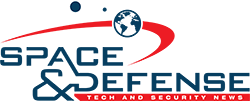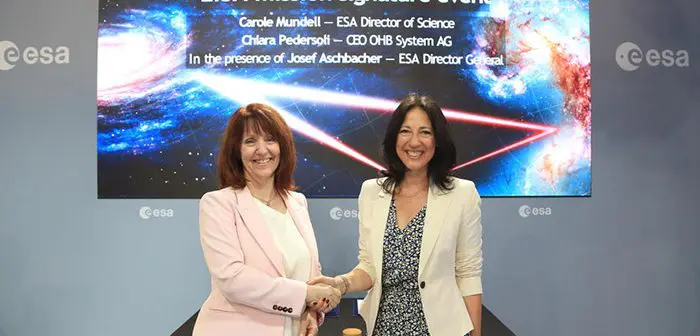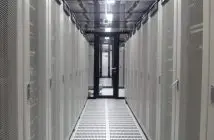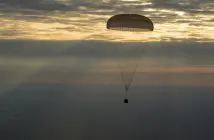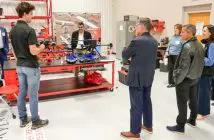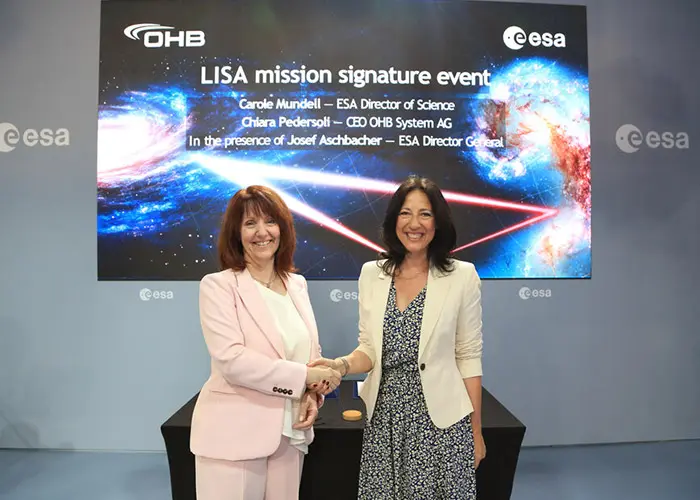
The European Space Agency (ESA) and OHB System AG have sealed their agreement to build ESA’s Laser Interferometer Space Antenna, LISA. The triple-spacecraft mission will be the first space-based observatory to study gravitational waves.
The signing took place at the International Paris Air Show and officially kicks off the industrial development of the mission. In collaboration with the LISA team, OHB will now finalise the spacecraft design and begin its construction.
“We are immensely proud that ESA and the scientific community entrust us to implement this groundbreaking science mission,” said OHB System CEO Chiara Pedersoli.
“LISA represents many years of pioneering technology developments, hope and belief of our scientific community, and steadfast support from our ESA member states,” said ESA Science Director Carole Mundell.
“As the first space mission designed to capture gravitational waves, LISA will open a brand-new window on the dark Universe and test the known laws of physics to their extreme. When it is flying, LISA will also represent the triumph of precision engineering and international cooperation on a new scale and place Europe at the forefront of space technology and fundamental science.”
LISA is a large-class mission to detect elusive ripples in spacetime. From its vantage point in space, LISA will capture gravitational waves of lower frequencies than is possible from Earth, uncovering events of a different scale.
This will enable scientists to trace how massive black holes merge and grow across cosmic ages, explore the fundamental nature of gravity, and study the rate at which the Universe expands.
LISA will provide new insights into the formation and evolution of tens of thousands of compact binary star systems, and advance our understanding of stellar-origin black holes.
To achieve this feat, LISA is designed to be a constellation of three spacecraft. They will fly in a triangular formation, trailing Earth in its orbit around the Sun. Each side of the equilateral triangle will span 2.5 million kilometres, more than six times the Earth-Moon distance.
Flying a trio of spacecraft over such large distances has never been attempted before. And as if that were not difficult enough, the spacecraft will exchange laser beams with each other over their vast separation.
The launch of the three spacecraft is planned for 2035 on an Ariane 6 rocket.
Each spacecraft carries a pair of solid gold-platinum cubes, so-called test masses (slightly smaller than Rubik cubes), free-floating in special housings. Gravitational waves will cause tiny changes in the distances between the golden cubes in the different spacecraft.
To capture the spacetime ripples, the mission will track these tiny shifts using the uniquely sensitive yardstick of laser interferometry – hence the mission’s name, Laser Interferometer Space Antenna.
This technique requires shooting laser beams from one spacecraft to the other and then superimposing their signal to determine changes in the masses’ distances down to a few billionths of a millimetre, or shifts of less than the diameter of a helium atom, over a distance of 2.5 million kilometres.
Led by ESA, the LISA mission is a collaboration between ESA, its member states, NASA, and an international consortium of scientists.
The spacecraft is being built and assembled by the industrial core team led by OHB, together with Thales Alenia Space.
Key hardware elements procured by ESA’s member states include the free-falling test masses shielded from external forces, provided by Italy and Switzerland; the picometre-accuracy systems to detect the interferometric signal, provided by Germany, the UK, France, the Netherlands, Belgium, Denmark and the Czech Republic; and the Science Diagnostics Subsystem (an arsenal of sensors across the spacecraft), provided by Spain.
